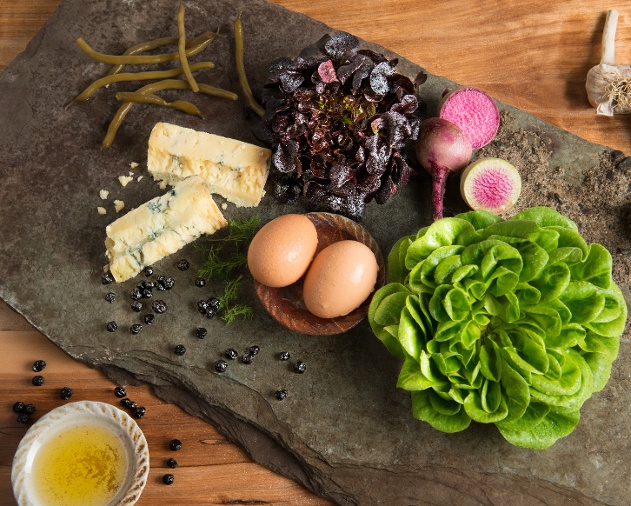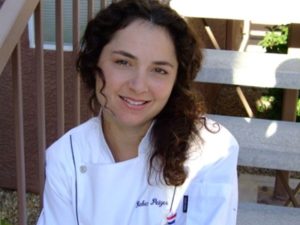Storytelling with a Wild Edge, A National Food Phenomenon
Editorial consulting by the Culinary Institute of America
For about seven years, I worked as a private chef for some of New York City’s most elite while they escaped the rush and fury of the city on the weekends to the sandy shores off Fire Island. I lived on the beach and on days off, I fished, collected seashells, and flew kites. But nothing beat trapping blue crabs, clamming for little necks with my feet and wandering the desolation of the enormous dunes picking wild berries.

My clients would arrive for the weekend and feast on a selection of these wild foods: crab cakes, clams casino, pan-seared striped bass, and buttermilk pancakes with wild blueberry maple syrup. They enticed their friends to visit with descriptions of the intensity of these wild flavors and, week after week, they couldn’t get enough of these specialties.
No other chef in the community was foraging for food at the time, so none could spin the same story, which in turn dramatically increased the allure of the food. The notion and description of the wild harvest actually became part of the deliciousness of the experience. My clients would extol, “Chef Rebecca procured these naturally occurring foods with her own two hands and bare feet!”
[blog_cta post_id=”16173″]
Stories enhance the sensuality of food by adding emotion and connection. Wild foods connect us to pristine, undisturbed, and most likely beautiful places. Mere mentions of Mom’s Apple Pie or Aunt Jenny’s Chicken and Dumplings also transport us to a different time and place. When we eat these foods as made by others, we remember how having them as a child was so comforting. In some cases, the replicated experience is even more intense than the original. As the poet Maya Angelou said, “people will forget what you said, people will forget what you did, but people will never forget how you made them feel.”
Before Alice Waters first started putting the names of the farms or producers on the actual menu at Chez Panisse in Berkeley California, diners really didn’t have much connection to the foods they ate at restaurants. But once the names of the farmers and fishermen were written as part of the menu description, people wanted to know more. Where is this food grown? How many years has the family owned the farm? Or as in the case at Mama’s Fish house in Paia on Island of Maui in Hawaii, who was the fisherman who caught the fish and how long was the struggle to reel it in?

Feeling connected to the food we are eating is more than a growing trend, it’s a movement that has gone mainstream. Facebook and Instagram feeds are filled with photos posted of someone’s dinner, snack or beverage. We are obsessed with sharing the experience of food. Food sellers everywhere – from restaurants to commodity boards to manufacturers – have found a marketing gold mine. Clif Bar’s “Farmer’s Speak” series is a visual story about the multigenerational farm that grows oats for their energy bars. Panera Bread’s “Live Consciously, Eat Deliciously Campaign” taps into memories of childhood games with a Rube Goldberg device to show how every ingredient they use is connected. But it doesn’t take Rube Goldberg to explain that products with connections stir emotions that lead to sales and satisfaction.
There is a brewery I like to visit every so often that has a fantastic selection of local beers and a great menu of pub food to accompany. One particular dish they serve is “Uncle Poodie’s Secret Onion” which is a simple dish of a slow baked onion with spices. Who was Uncle Poodie? And why is this onion so famous that it deserved his name on the menu? It is a secret that the owners will never divulge, and even that mystery becomes part of the story. It keeps me, and every other customer coming back and ordering it time and time again. It reminds me of when I was a child being told the same bedtime story night after night. It is familiar, comforting, and so very special.
Which is why I’m telling you about it now.
About the Author

Chef Rebecca Peizer, C.H.E. C.E.C.
Associate Professor of Culinary Arts
Culinary Institute of America at Greystone
Rebecca’s passion for food set her on a path to the Culinary Institute of America where she graduated in 2000. From there, she set off to New York City where she became a private chef. She took her next big step in the culinary world when she moved to California and opened Roux, a restaurant in St. Helena in the heart of the Napa Valley. Roux quickly took off and the San Francisco Chronicle named it Top 10 Restaurants in the Bay Area 2001. On the heels of that honor, Food & Winenamed her Top 10 Sous Chefs in America 2002. Over the course of her career, Rebecca has had the opportunity to work with many great chefs including Jacques Pepin, Martin Yan, Bradly Ogden, Cindy Pawlcyn, and Julia Childs. She has catered events for presidential candidates, Napa Valley winemakers, and prominent artists, and now shares her passion for food and wine with students at the Culinary Institute of America at Greystone in Napa Valley.

